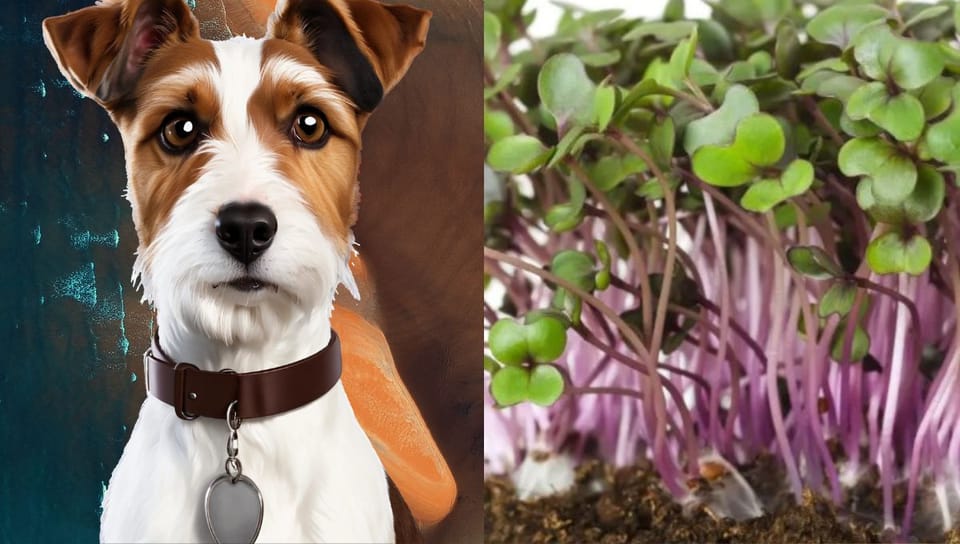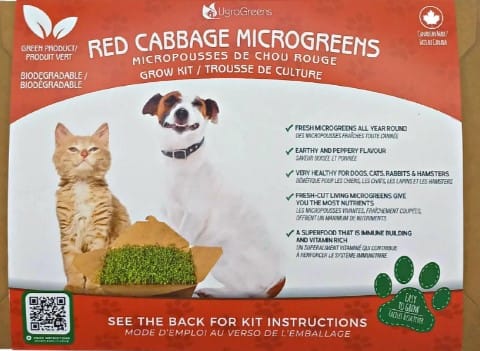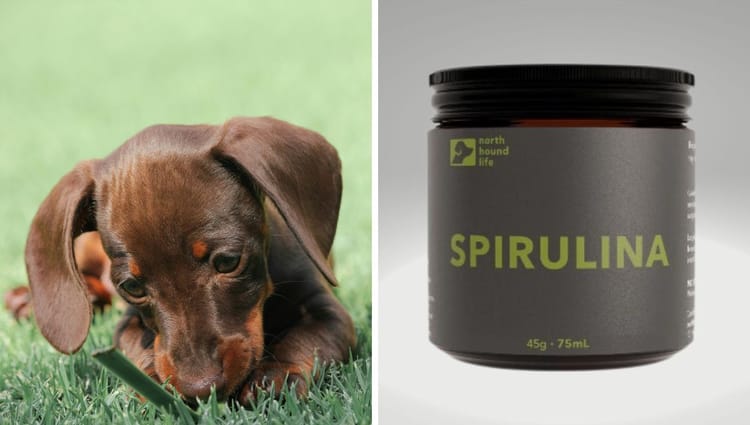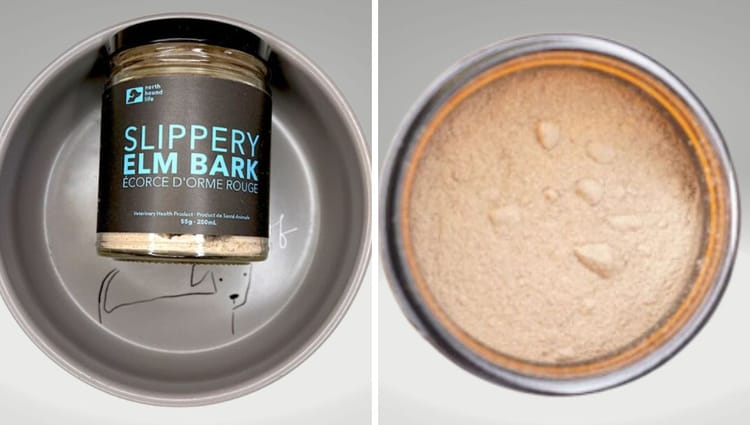Paw-sitively Delicious: Red Cabbage Microgreens for Your Furry Friend

Introduction to Red Cabbage Microgreens
Red cabbage microgreens are the young, tender shoots of the red cabbage plant. These tiny greens pack a punch in terms of nutrition and are becoming increasingly popular among health-conscious pet owners. Unlike mature cabbage, microgreens are harvested just a few weeks after germination, making them rich in vitamins, minerals, and antioxidants.
For dogs, incorporating red cabbage microgreens into their diet can provide a variety of health benefits. These microgreens are easy to grow at home and offer a fresh and natural way to boost your dog's overall well-being. Let's dive into the specifics of why red cabbage microgreens are a fantastic addition to your furry friend's diet.
Key Takeaways:
- Red cabbage microgreens are a nutritious addition to your dog's diet.
- They offer numerous health benefits, including improved digestion and immune support.
- Introducing microgreens to your dog's meals can be simple and rewarding.
Nutritional Benefits of Red Cabbage Microgreens
Red cabbage microgreens are a powerhouse of nutrients. They contain high levels of vitamins A, C, and K, which are essential for maintaining your dog's health. Vitamin A supports vision and immune function, while vitamin C is a potent antioxidant that helps combat free radicals. Vitamin K plays a crucial role in blood clotting and bone health.
In addition to vitamins, red cabbage microgreens are rich in minerals such as calcium, magnesium, and potassium. These minerals are vital for maintaining strong bones, proper muscle function, and overall cellular health. The high fibre content in these microgreens also aids in digestion, ensuring your dog maintains a healthy gut.

Health Benefits for Dogs
Feeding your dog red cabbage microgreens can lead to numerous health benefits. One of the most significant advantages is improved digestion. The fibre in these microgreens helps regulate bowel movements and promotes a healthy gut microbiome. This can be particularly beneficial for dogs with sensitive stomachs or digestive issues.
Another notable benefit is the boost to the immune system. The antioxidants found in red cabbage microgreens help protect your dog's cells from damage and support overall immune function. This can lead to a reduced risk of infections and illnesses, keeping your dog healthier and happier.
How to Introduce Microgreens to Your Dog's Diet
Introducing red cabbage microgreens to your dog's diet is a straightforward process. Start by adding a small amount to their regular meals and gradually increase the quantity over time. This allows your dog's digestive system to adjust to the new addition without causing any discomfort.
You can mix the microgreens into your dog's food or use them as a topping. Some dogs may enjoy the taste and texture of fresh microgreens, while others might need a bit of encouragement. If your dog is hesitant, try mixing the microgreens with a favourite treat or wet food to make them more appealing.
Growing Red Cabbage Microgreens at Home
Growing red cabbage microgreens at home is a fun and rewarding activity. All you need is a shallow container, some soil, and red cabbage seeds. Fill the container with soil, sprinkle the seeds evenly, and cover them with a thin layer of soil. Keep the soil moist and place the container in a sunny spot.
Within a week or two, you'll see the seeds sprout and grow into vibrant microgreens. Once they reach about 2-3 inches in height, they are ready to harvest. Simply snip the greens at the base and rinse them thoroughly before feeding them to your dog. Growing your microgreens ensures they are fresh and free from harmful chemicals.
Safety Considerations
While red cabbage microgreens are generally safe for dogs, it's essential to introduce them gradually and monitor your dog's reaction. Some dogs may have allergies or sensitivities to certain foods, so it's crucial to watch for any signs of adverse reactions, such as vomiting, diarrhea, or itching.
If your dog has any pre-existing health conditions or is on medication, consult your veterinarian before adding microgreens to their diet. This ensures that the new addition won't interfere with their treatment or exacerbate any health issues.
Case Studies: Success Stories
Many dog owners have reported positive results after incorporating red cabbage microgreens into their pets' diets. For example, one owner noticed a significant improvement in their dog's coat condition and energy levels after just a few weeks of adding microgreens to their meals.
Another case involved a dog with chronic digestive issues. After introducing red cabbage microgreens, the dog's symptoms improved dramatically, leading to more regular bowel movements and less discomfort. These success stories highlight the potential benefits of adding microgreens to your dog's diet.
Comparing Microgreens to Other Greens
When comparing red cabbage microgreens to other greens, such as spinach or kale, it's clear that microgreens offer unique advantages. While all greens provide essential nutrients, microgreens are often more nutrient-dense due to their early harvest stage. This means they pack more vitamins and minerals into a smaller serving size.
Additionally, microgreens are easier to digest than mature greens, making them a better option for dogs with sensitive stomachs. Their mild flavour and tender texture also make them more palatable for picky eaters. Overall, red cabbage microgreens stand out as a superior choice for enhancing your dog's diet.
Common Misconceptions
There are several misconceptions about feeding dogs microgreens. One common myth is that microgreens are too rich and can cause digestive upset. While it's true that introducing any new food should be done gradually, microgreens are generally well-tolerated by dogs when given in appropriate amounts.
Another misconception is that microgreens are difficult to grow and maintain. In reality, growing microgreens at home is a simple process that requires minimal effort and resources. With a little patience and care, you can provide your dog with a fresh and nutritious food source right from your own home.
Tips for Success
To ensure success when feeding your dog red cabbage microgreens, follow these tips. First, always start with a small amount and gradually increase the serving size. This helps your dog adjust to the new food without any digestive issues. Second, make sure to rinse the microgreens thoroughly before feeding them to your dog to remove any dirt or contaminants.
Lastly, be consistent with the addition of microgreens to your dog's diet. Regularly incorporating them into meals will provide the most significant health benefits. By following these tips, you can confidently add red cabbage microgreens to your dog's diet and enjoy the positive results.
Summary
Red cabbage microgreens are a nutritious and beneficial addition to your dog's diet. Packed with essential vitamins, minerals, and antioxidants, these tiny greens can improve digestion, boost the immune system, and enhance overall health.
Growing microgreens at home is a simple and rewarding process, ensuring your dog receives fresh and chemical-free greens. By introducing red cabbage microgreens gradually and monitoring your dog's reaction, you can provide a healthy and delicious supplement to their regular meals.
FAQ
1. Can all dogs eat red cabbage microgreens?
Most dogs can safely eat red cabbage microgreens, but it's essential to introduce them gradually and monitor for any adverse reactions. If your dog has any pre-existing health conditions or is on medication, consult your veterinarian before adding microgreens to their diet.
2. How much red cabbage microgreens should I feed my dog?
Start with a small amount, such as a teaspoon, and gradually increase the serving size over time. The appropriate amount will depend on your dog's size and dietary needs. Always monitor your dog's reaction and adjust the serving size accordingly.
3. Are there any risks associated with feeding dogs red cabbage microgreens?
While red cabbage microgreens are generally safe, some dogs may have allergies or sensitivities to certain foods. Watch for signs of adverse reactions, such as vomiting, diarrhea, or itching. If you notice any of these symptoms, discontinue feeding the microgreens and consult your veterinarian.





